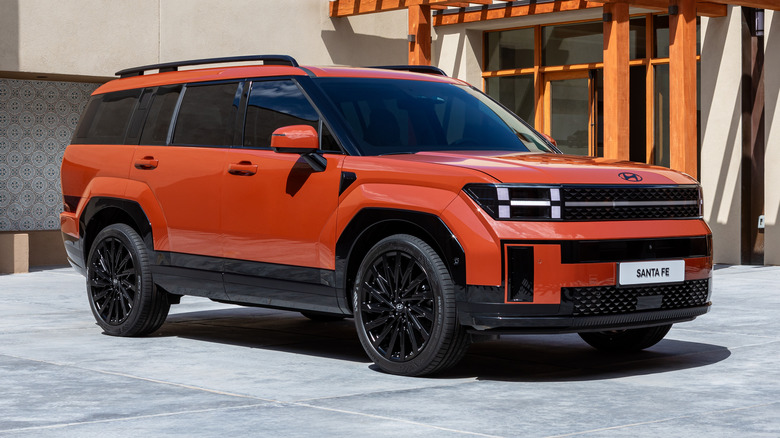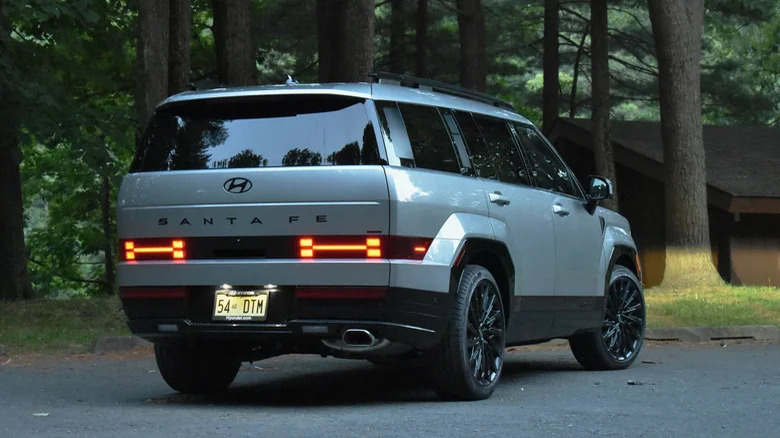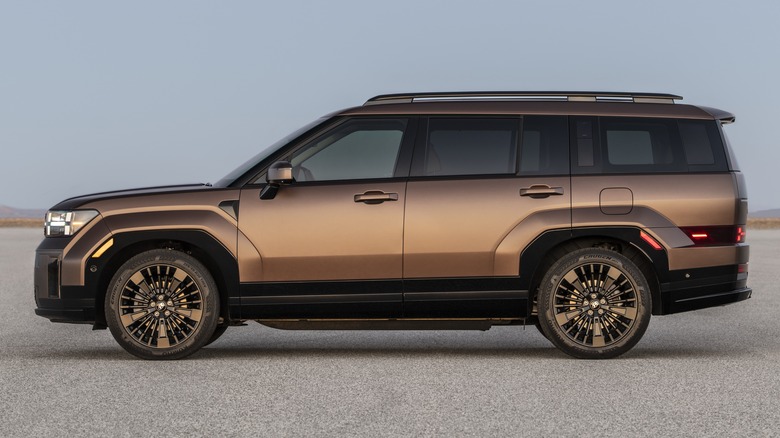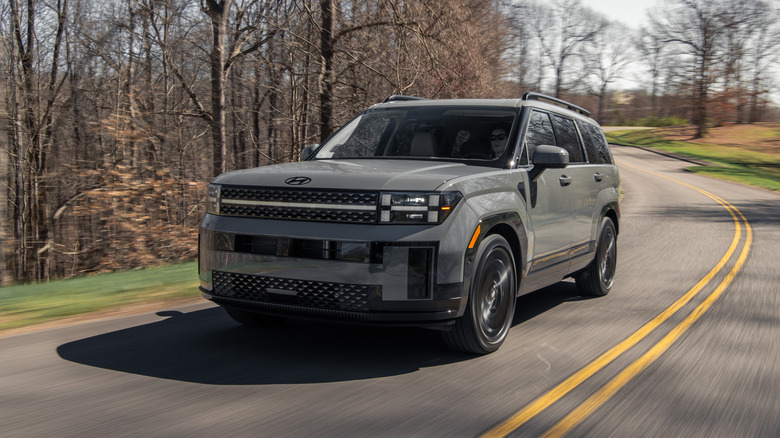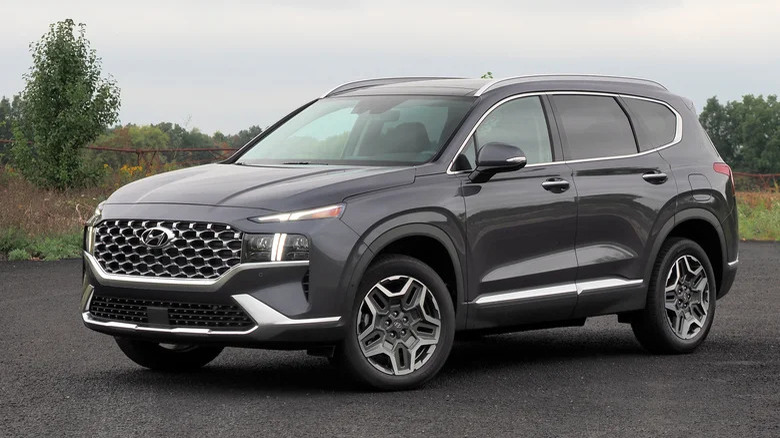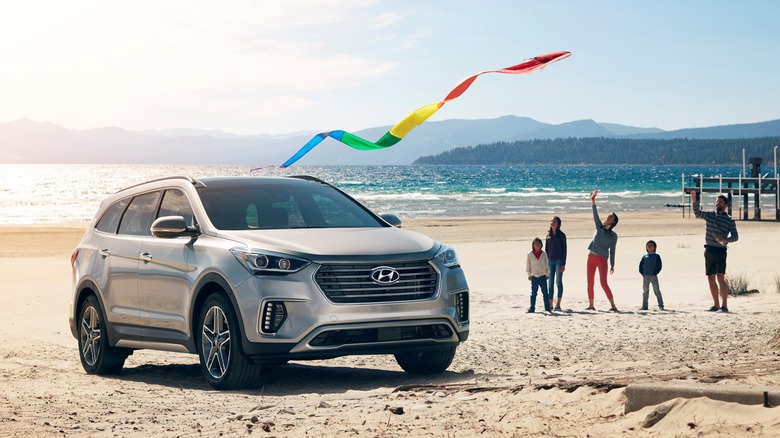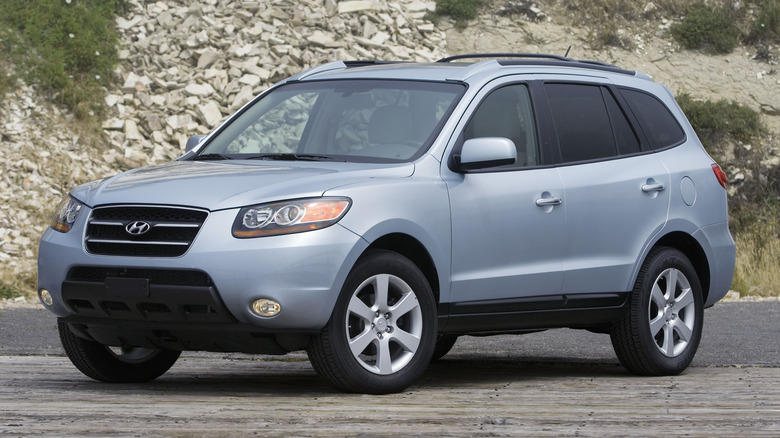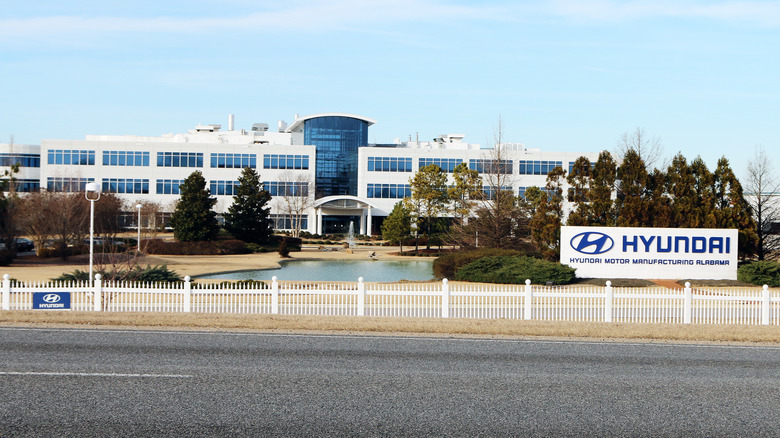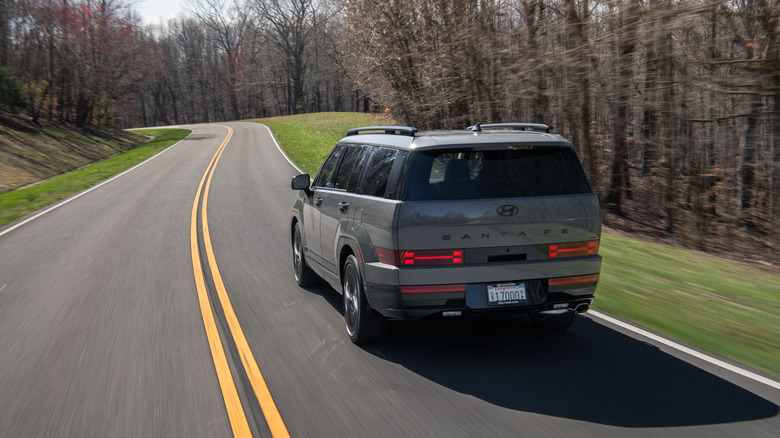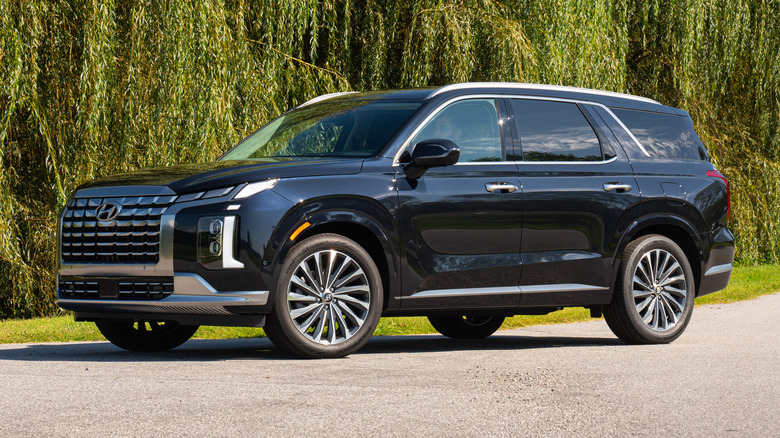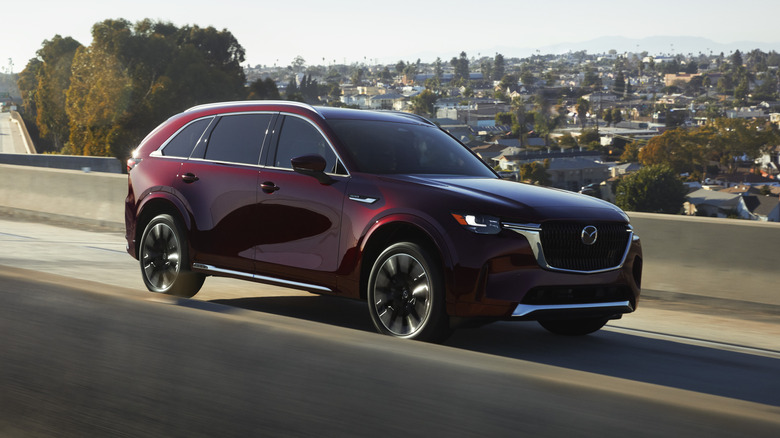10 Things You Should Know Before Buying A Hyundai Santa Fe (New Or Used)
Hyundai's current lineup includes an extended range of SUVs and crossovers, with one of the most popular being the midsize Santa Fe. The midsize SUV segment is a fiercely competitive one and has been so for many years, which is why the Santa Fe's continued success is no fluke. The model offers buyers a combination of practicality, efficiency, and comfort, and it does so at a price that undercuts many of its rivals. For the 2024 model year, it was also given an eye-catching new look too.
Older model years are also worth considering for buyers looking for an affordable used family hauler, although some model years are better picks than others. We've combined the expertise of SlashGear's review team with data on the Santa Fe's reliability and resale values to create a roundup of ten top tips that buyers should be aware of before they consider a Santa Fe, whether it's a new or used example.
The Santa Fe was given an overhaul for 2024
The Santa Fe of old was not a particularly distinctive looking crossover, but the same cannot be said about the latest iteration. Unveiled for the 2024 model year, the new, boxier Santa Fe borrows heavily from the looks of off-road classics, but manages not to look too much like a rip-off of any single one. Its H-shaped lights are a unique feature, with that design element employed for both the headlights and taillights.
Elsewhere, things are not so original. If you take a look at the car's exterior design you'll see elements of the Land Rover Defender, while some interior design elements seem to be borrowed from Mercedes-Benz. To be clear, that's not necessarily a bad thing, especially since the Santa Fe does a generally good job of bringing these varied elements together into one cohesive package.
While its looks are all-new, existing Santa Fe owners might find the car's driving experience to be more familiar than they initially expect. That's largely because the platform underpinning the 2024 model remains the same from previous model years, despite the drastic styling changes. The engine range remains similar too, with a choice of two turbocharged four-cylinders on offer. The standard variant is a 2.5L, and a hybrid 1.6L is also available.
2024 models start around $35,000
The cheapest new Santa Fe for 2024 is the non-hybrid SE trim, which comes with a starting MSRP of $33,950. That figure excludes Hyundai's compulsory delivery charge, which adds a further $1,415, bringing the total starting price up to $35,365. The SEL is the next step up in the range, adding a roughly $2,500 premium and offering a broader range of niceties including wireless device charging and Hyundai Digital Key compatibility.
The XRT trim marks the midpoint of the trim range, starting at $42,015 including fees and bringing standard all-wheel drive and all-terrain tires. Then, the luxurious Limited and Calligraphy trims top out the range, with the latter offering Nappa leather seats and second row captain's chairs as standard. The Calligraphy starts from $47,895 including fees, and with every option ticked, that price can increase to around $52,000.
Hybrid variants of the Santa Fe get a reduced trim range, with only the SEL, Limited, and Calligraphy trims available. Prices start at $36,950 for the SEL, while the hybrid Calligraphy costs at least $47,000. Hyundai has announced its pricing for the upcoming 2025 model year, with increases of a few hundred dollars across most trims. It's a carryover model, which means the range of trims remain unchanged from the previous year. As of this writing, the 2024 model year remains the most recent model available in dealerships.
The Santa Fe Hybrid is the clear winner for efficiency
Although none of the 2024 Santa Fe variants are particularly gas guzzling, it's the hybrid that comes out firmly on top for buyers trying to save money at the gas pump. The most efficient powertrain option is the front-wheel drive hybrid, which achieves EPA-estimated figures of 36 mpg city, 35 mpg highway, and 36 mpg combined. Adding all-wheel drive has only a minor detrimental effect on mpg, knocking those figures down to 35 mpg, 34 mpg, and 34 mpg, respectively.
In contrast, the non-hybrid Santa Fe achieves EPA figures of 20 mpg city, 29 mpg highway, and 24 mpg combined in its most efficient front-wheel drive trim. The off-road tires and all-wheel drive of the XRT trim make it the worst performer for efficiency, being rated at 19 mpg city, 26 mpg highway, and 22 mpg combined. That configuration makes the Santa Fe slightly thirstier than similar non-hybrid rivals like the Toyota Grand Highlander and Volkswagen Atlas, but it still is around average for its class.
The previous generation Santa Fe is still competitive
Anyone who is not sold on the revised styling of the 2024 model might want to look back to 2023, as there's still a lot to like about the previous generation of the car. For starters, there's a plug-in hybrid variant available, with up to 31 miles of all-electric range. As of this writing, no plug-in hybrid is offered yet for the latest generation Santa Fe.
The non-PHEV 2023 Santa Fe is also worth considering, since it offers generous levels of equipment as standard and plenty of cabin space. Its efficiency is also broadly comparable to the latest generation, and thanks to a generous warranty, there should be no need to worry about unexpected repair bills. Aside from looks, the biggest change between the previous and current generations is that previous generation cars feature only two rows, while the latest generation gains an extra pair of seats in the third row. If that's a dealbreaker, it might be worth considering the 2023 Hyundai Palisade instead.
Older generations can be found for attractively low prices
The fourth generation Santa Fe was launched for the 2019 model year and remained in production through the 2023 model year, but buyers on tighter budgets can look back further to the first three generations of the car. The Santa Fe was first launched for the 2001 model year, with the second generation arriving for 2007 and the third for 2013. Each generation built on the success of its predecessor, with Hyundai offering successively more standard equipment and more upscale interiors with each generation.
Used values vary significantly based on condition and mileage as well as model year, but in general, older models can be picked up cheaply. For example, KBB lists the current resale value of a 2010 second generation Santa Fe as $4,062, while a 2015 model is valued at $6,520. Buying any older car requires a greater degree of caution than buying a nearly new model, as there's a higher risk that a previous owner will have treated it poorly. To mitigate that risk, it's worth looking out for the telltale used car red flags, and avoiding examples that show signs of previous neglect.
Some used models are worth steering clear of
While many used Santa Fe years can be picked up for low prices, not all of them are necessarily bargains. Like any major manufacturer, Hyundai has seen its fair share of quality blips over the years, and some Santa Fe models have significantly higher rates of owner complaints than others. According to NHTSA data, the 2017 and 2007 model years are the worst offenders, with 743 and 672 complaints respectively as of this writing.
The majority of complaints about the 2017 model concern premature engine failure, while owners of the 2007 model report various electrical gremlins from faulty stability control systems to persistent engine warning lights. Other Santa Fe model years with higher than average levels of complaints include the 2007, 2008, 2013, and 2014 model years.
Most Santa Fe models have also been subject to one or more recalls, and so it's worth checking the recall history of any given model year before buying a used example. The best way to do that is through the NHTSA's recall database. Then, be sure to check whether there's evidence that the car you're considering has had the required recall work carried out.
The Santa Fe is one of three Hyundai models made in America
From its first generation a quarter century ago, the Santa Fe has always been designed with American buyers in mind. The first generation's design was in fact a collaboration between Hyundai California Design studio and the brand's Korean division. Later generations adapted the car for a more global audience, with Hyundai's Global Design Center in South Korea being chiefly responsible for the Santa Fe's recent redesign.
The car is one of three Hyundai models manufactured at HMMA, the brand's production facility in Montgomery, Alabama. The automaker spent $190 million upgrading and retooling the plant in preparation for the new generation of the SUV, which should mean that the Santa Fe remains an American-made car for the foreseeable future. The two other Hyundai models manufactured at the plant are the Tucson crossover and Santa Cruz pickup. HMMA also produces both electric and gas powered versions of the Genesis GV70 at the plant.
Depreciation levels are around average
Virtually every new car will depreciate over time, but some models depreciate significantly faster than others. Hyundai's historic reputation as a maker of cheap economy cars hasn't helped its resale values in the past, but the brand's modern cars hold their value a lot better than their predecessors. According to KBB data, the average new car loses around 60% of its value over its first five years. The 2024 Santa Fe, while not the best in class, is around average, with depreciation levels of around 59% over five years according to KBB.
That figure is only an estimate, and actual value can vary by condition and mileage. In general though, Santa Fe buyers shouldn't need to worry about their vehicle plummeting in value during the time that they own it. However, buyers looking for the best performing midsize SUV in terms of retaining value will want to look elsewhere in Hyundai's lineup. For 2024, KBB gave that title to the Hyundai Palisade.
The Santa Fe isn't the only midsize Hyundai SUV
Aside from beating the Santa Fe in retaining value, the larger Palisade SUV is also worth considering for several other reasons. It's slightly more expensive, but is also slightly roomier and offers less polarizing exterior styling. Much like the Santa Fe, a wide range of trims are available, from budget-oriented to luxurious, but each is decently equipped for its price point. The Palisade also features a larger and more powerful engine, with a 3.8L V6 being the only option. However, with no hybrid available, the pricier SUV is less efficient than the Santa Fe.
The Palisade also misses out on a few tech upgrades that its stablemate offers, including wireless Android Auto and Apple CarPlay. Standard safety tech remains competitive in each model, with Highway Driving Assist available on higher trims. Both SUVs offer a similar appeal, especially since the latest Santa Fe regained its third row, and which one to pick comes down to personal tastes more than anything else.
Midsize SUV buyers have lots of options to choose from
Buyers willing to look outside of Hyundai's range for a midsize SUV have a huge range of competitors to pick from, although many require slightly deeper pockets. The Kia Telluride, for example, shares a platform with the Palisade and starts just a couple thousand dollars higher than the Santa Fe. Our reviewer was particularly impressed with the Kia's top-spec trim, which featured higher quality materials and a better fit and finish than its price might suggest.
The Mazda CX-90 is another great option, as it's one of the only midsize SUVs to prioritize driver enjoyment rather than solely focusing on passenger ride comfort. It's also impressively upscale in higher trims, and exceeded its EPA efficiency figures during our mixed test route. The Santa Fe has plenty of competition, then, but even with that competition, it's still an appealing vehicle in both new and used form.
